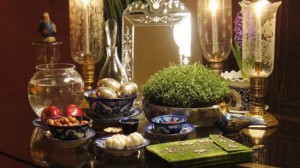 Millions of Persian-speaking people around the world are preparing to celebrate the Persian New Year by holding traditional Nowruz festivities.
Millions of Persian-speaking people around the world are preparing to celebrate the Persian New Year by holding traditional Nowruz festivities.
Nowruz (new day) which coincides with the astronomical Vernal Equinox Day or the first day of spring is as one of the oldest and most cherished festivities celebrated for at least 3,000 years.
According to master of Persian epic poetry Ferdowsi, Nowruz festivities date back to the time of mythological Iranian king Jamshid who saved mankind from a killer winter that was destined to kill every living creature.
The term Nowruz in writing first appeared in Persian records in the 2nd century CE, but it was also an important day during the time of the Achaemenids, when kings from different nations under the Persian Empire used to bring gifts to the Emperor.
Nowruz is celebrated and observed principally in Iran, but people in Asia, the Indian subcontinent, Central Asia, the Middle East, the Caucasus, the Balkans, the Black Sea and many other parts of the world also hold New Year’s celebration according to Persian calendar.
For Iranians, Nowruz is a celebration of renewal and change, a time to visit relatives and friends, and pay respect to senior family members. They prepare to welcome the New Year days before coming the spring by cleaning their homes and buying new clothes.
Furthermore, to welcome the New Year and spring people mark several inherited celebrations such as Chahar Shanbeh Suri or the Wednesday Festival.
Chahar Shanbeh Suri is known as the festival of fire which was celebrated by ancient Iranians to welcome visiting spirits and angels who they believed descended before the New Year came.
Iranians now follow the tradition as a celebration of light (the good) winning over darkness (the evil).
At the first day of the New Year, people often spend time to prepare and cook the most lavish meal of the year as the family members get together. According to the tradition, ‘Herbed Rice and Fish (Sabzi Polo va Mahi)’ is frequently served.
There is also special table setting for the New Year called ‘Haft Seen’ which traditionally symbolizes light, warmth, life, love, joy, production, prosperity, and nature.
Haft Seen is a table containing seven items starting with the phonemic Farsi equivalent of the English letter 'S' or 'Seen.' Sabzeh (freshly grown greens), Samanu (sweet wheat paste), Senjed (jujube), Seeb (apple), Seer (garlic), Somagh (sumac), and Sekeh (coin), are among items that begin with the Farsi letter Seen.
Iranians also believe an individual's conduct in Nowruz will affect their lives throughout the year; therefore, they abstain from fights and disagreements to ensure a good year.
The International Day of Nowruz was registered on the UNESCO List of the Intangible Cultural Heritage of Humanity on February 23, 2010, and the festivities are now celebrated in many countries as far as the US and Canada.
The United Nations also promotes Nowruz by holding celebrations and introducing the tradition as a representation of peace and solidarity between generations and within families as well as reconciliation and neighborliness among peoples and different communities.
The 13-day Nowruz celebration of spring is Iran’s most important holiday.
The Persian New Year will begin on March 20, 2014, at 08:27:07 PM local time in Iran.
By Press TV
The Iran Project is not responsible for the content of quoted articles.

 QR code
QR code